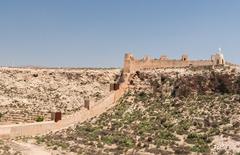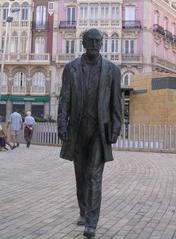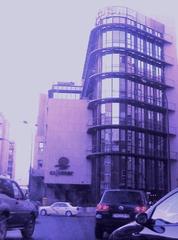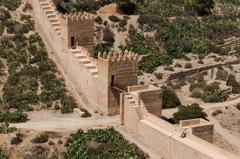Complete Guide to Almería City Council: Visiting Hours, Tickets, and Nearby Historical Sites
Date: 03/07/2025
Introduction
Situated in the heart of Andalusia, the Almería City Council (Ayuntamiento de Almería) is a focal point for both civic life and historical exploration. Located at Plaza de la Constitución, this neoclassical building is a striking landmark in Almería’s historic center, surrounded by centuries of architectural, cultural, and urban evolution. Visitors can expect not only a glimpse into municipal governance but also access to a vibrant network of monuments, festivals, and revitalized urban spaces. This detailed guide covers the essential history, practical visiting information, and insights into nearby attractions to help you plan a rewarding visit. For planning resources, consult the official Almería City Council website, Andalucia.com, and Visit-Andalucia.
Table of Contents
- Historical Overview
- Visiting Almería City Council: Hours, Tickets, and Accessibility
- Guided Tours and Visitor Experience
- Festivals and Special Events
- Nearby Historical Sites and Landmarks
- Urban Renewal and Modernization Initiatives
- Visitor Tips and Frequently Asked Questions
- Visual and Interactive Resources
- Conclusion
- References
Historical Overview
Prehistoric and Ancient Foundations
Archaeological evidence points to continuous settlement in the Almería area since the Neolithic, Copper, and Bronze Ages. Sites like Los Millares reveal early trade links with North Africa, while Phoenician and Roman remains are found on the Alcazaba hill. The Roman period left traces such as the ancient road of Bayyana, still traceable near the city’s outskirts (Visit-Andalucia, Turismo de Almería).
Islamic Golden Age
Founded in 955 AD by Caliph Abd al-Rahman III, Almería (Madīnat al-Mariyya) rose rapidly as a key port and naval base for the Caliphate of Córdoba. The 11th and 12th centuries marked the city’s peak, with the port dominating Mediterranean trade in silk, oil, and other goods. The famed silk industry was supported by hundreds of looms and local mulberry trees, while architectural legacies such as the Alcazaba fortress, water cisterns, and city walls remain central to the city’s landscape (Wikipedia, Visit-Andalucia, Turismo de Almería).
Christian Conquest and Modern Era
In 1489, Almería surrendered to Ferdinand and Isabella, ending Islamic rule. The city faced periods of decline due to pirate raids, the expulsion of its Jewish community, and shifting trade patterns. The 19th century brought renewed growth with the mining boom, resulting in urban expansion, new infrastructure, and the emergence of the Plaza Vieja (now Plaza de la Constitución) as a civic center (Wikipedia, beaire.com, Visit-Andalucia).
The 20th century saw further transformation, with the rise of intensive greenhouse agriculture and tourism following the decline of mining. Almería’s landscapes became prominent in international film, spurring hotel and airport development and renewed investment in heritage sites (beaire.com, Visit-Andalucia).
Urban Transformation and Contemporary Almería
Today, Almería is a dynamic city blending historical preservation with modernization. The City Council, set in Plaza de la Constitución, anchors a district rich in monuments, contemporary museums, and restored public spaces. Major events and festivals reinforce a vibrant civic identity, while ongoing urban renewal projects ensure accessibility, sustainability, and enhanced visitor experiences (Andalucia.com, Euro Weekly News).
Visiting Almería City Council: Hours, Tickets, and Accessibility
Opening Hours
- Monday to Friday: 9:00 AM – 2:00 PM
Check the official website or the Tourist Office for seasonal updates and public holiday information.
Tickets and Entry
- Entry: Free of charge for general access.
- Guided Tours and Special Exhibitions: May require advance booking and a nominal fee, especially for exhibitions in the Centro de Interpretación Patrimonial.
Accessibility
- Wheelchair access via ramps and adapted facilities.
- Multilingual signage and assistance available at the Tourist Office.
- The surrounding Plaza de la Constitución is also pedestrian-friendly and accessible.
Guided Tours and Visitor Experience
- Guided Walking Tours: Offered by the Almería Tourist Office and local guides, these tours provide in-depth insights into the City Council’s history, architecture, and role in civic life (Sian Victoria).
- Booking: Advance reservation is recommended, particularly during spring and summer.
- Tips: Early mornings and late afternoons are ideal for visiting, avoiding midday heat and crowded periods.
Festivals and Special Events
The City Council and Plaza de la Constitución host numerous annual events, including:
- Semana Santa (Holy Week)
- Feria de Almería (August)
- Carnaval and Noche de San Juan
- Flamenco Festival and “Almería Summer Vibes”
These events often feature concerts, parades, and open-air performances, attracting thousands of attendees and showcasing Almería’s rich cultural heritage (Visiting Almería, Weeky.es).
Nearby Historical Sites and Landmarks
- Alcazaba of Almería: The largest Andalusian fortress on the Iberian Peninsula, with three enclosures and panoramic city views (andalucia.com).
- Muralla de Jayrán: 11th-century defensive wall, following the hills north of the Alcazaba (architectural-review.com).
- Almería Cathedral: A Renaissance cathedral with fortress features, originally built to defend against pirate raids (spainguides.com).
- Civil War Shelters: Underground galleries built in 1937–38 for civilian protection during the Spanish Civil War (raizes.es).
- Centro de Interpretación Patrimonial: A contemporary museum offering exhibits on the city’s evolution (lonelyplanet.com).
- Mercado Central and Paseo de Almería: Lively markets and promenades linking the historic core with modern shopping and dining.
Urban Renewal and Modernization Initiatives
Revitalization of the Historic City Center
Almería’s city core has been restored with a blend of heritage preservation and modern infrastructure. Pedestrianization, façade restoration, and upgrades to public squares foster a lively urban atmosphere.
Sustainable Infrastructure
Aligned with the Plan DUS 5000, the City Council has invested in solar energy, smart irrigation, and drought-resistant landscaping, particularly along the Rambla de Belén.
Technological Integration
Free public Wi-Fi, digital guides, and multilingual kiosks ensure visitors have access to information and event updates.
Enhanced Public Spaces
Renovations to plazas and promenades improve accessibility, seating, and lighting, encouraging community engagement and visitor comfort.
Restoration and Adaptive Reuse
Historic sites like the Museo Refugio de la Guerra Civil and Mercado Central have been adapted for modern use, serving as cultural and social hubs (Euro Weekly News).
Visitor Tips and Frequently Asked Questions
General Tips
- Best Time to Visit: Spring and early autumn for mild weather and vibrant festivals.
- Photography: Early morning or sunset for the best light on architectural landmarks.
- Cultural Etiquette: Respect ceremonies and avoid blocking entrances during events.
- Transport: The area is pedestrian-friendly; public transport and parking are readily available.
FAQs
Q: What are the visiting hours of Almería City Council?
A: Monday to Friday, 9:00 AM to 2:00 PM.
Q: Is there an entry fee?
A: Entry is free. Guided tours or special exhibitions may require tickets.
Q: Is the City Council building accessible for visitors with disabilities?
A: Yes, ramps and adapted pathways are provided.
Q: Are guided tours available?
A: Yes, book in advance through the Tourist Office.
Q: Can visitors attend council meetings?
A: Some public meetings may be open; check the official website for schedules.
Q: Are there public restrooms and information centers nearby?
A: Yes, facilities are available at Plaza de la Constitución and surrounding areas.
Visual and Interactive Resources
- Virtual Tours: Available on the official tourism website.
- Images: Seek high-quality photos of the City Council, Alcazaba, Cathedral, and revitalized plazas for a preview of your visit.
- Audiala App: Download for guided tours, maps, and real-time event updates.
Conclusion
The Almería City Council is both a symbol and a catalyst of the city’s enduring civic pride, bridging a storied past with a forward-looking present. Its neoclassical façade, central location, and role as a hub for festivals and urban renewal make it a must-visit for travelers seeking an immersive journey into Almería’s unique blend of history and modernity. With accessible public spaces, a full calendar of cultural events, and proximity to iconic sites like the Alcazaba and the Cathedral, the City Council area offers a comprehensive gateway to the city’s dynamic spirit.
Plan your visit using the Almería Tourist Office, consult digital resources, and embrace the vibrant experience that awaits in Almería’s historic heart.
References
- Visit-Andalucia: History of Almería City
- Sian Victoria: Almería Sightseeing & Landmarks Guide
- Andalucia.com: Alcazaba of Almería
- Euro Weekly News: Almería 2025 – Urban Transformation
- Wikipedia: Almería
- Andalucia.com: Plaza de la Constitución



